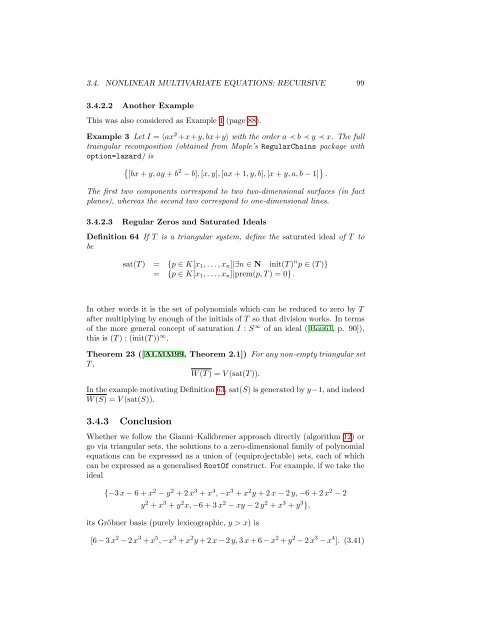Contents - Student subdomain for University of Bath
Contents - Student subdomain for University of Bath
Contents - Student subdomain for University of Bath
You also want an ePaper? Increase the reach of your titles
YUMPU automatically turns print PDFs into web optimized ePapers that Google loves.
3.4. NONLINEAR MULTIVARIATE EQUATIONS: RECURSIVE 99<br />
3.4.2.2 Another Example<br />
This was also considered as Example 1 (page 88).<br />
Example 3 Let I = 〈ax 2 +x+y, bx+y〉 with the order a ≺ b ≺ y ≺ x. The full<br />
traingular recomposition (obtained from Maple’s RegularChains package with<br />
option=lazard) is<br />
{<br />
[bx + y, ay + b 2 − b], [x, y], [ax + 1, y, b], [x + y, a, b − 1] } .<br />
The first two components correspond to two two-dimensional surfaces (in fact<br />
planes), whereas the second two correspond to one-dimensional lines.<br />
3.4.2.3 Regular Zeros and Saturated Ideals<br />
Definition 64 If T is a triangular system, define the saturated ideal <strong>of</strong> T to<br />
be<br />
sat(T ) = {p ∈ K[x 1 , . . . , x n ]|∃n ∈ N init(T ) n p ∈ (T )}<br />
= {p ∈ K[x 1 , . . . , x n ]|prem(p, T ) = 0} .<br />
In other words it is the set <strong>of</strong> polynomials which can be reduced to zero by T<br />
after multiplying by enough <strong>of</strong> the initials <strong>of</strong> T so that division works. In terms<br />
<strong>of</strong> the more general concept <strong>of</strong> saturation I : S ∞ <strong>of</strong> an ideal ([Bou61, p. 90]),<br />
this is (T ) : (init(T )) ∞ .<br />
Theorem 23 ([ALMM99, Theorem 2.1]) For any non-empty triangular set<br />
T ,<br />
W (T ) = V (sat(T )).<br />
In the example motivating Definition 63, sat(S) is generated by y−1, and indeed<br />
W (S) = V (sat(S)).<br />
3.4.3 Conclusion<br />
Whether we follow the Gianni–Kalkbrener approach directly (algorithm 12) or<br />
go via triangular sets, the solutions to a zero-dimensional family <strong>of</strong> polynomial<br />
equations can be expressed as a union <strong>of</strong> (equiprojectable) sets, each <strong>of</strong> which<br />
can be expressed as a generalised RootOf construct. For example, if we take the<br />
ideal<br />
{−3 x − 6 + x 2 − y 2 + 2 x 3 + x 4 , −x 3 + x 2 y + 2 x − 2 y, −6 + 2 x 2 − 2<br />
y 2 + x 3 + y 2 x, −6 + 3 x 2 − xy − 2 y 2 + x 3 + y 3 },<br />
its Gröbner basis (purely lexicographic, y > x) is<br />
[6 − 3 x 2 − 2 x 3 + x 5 , −x 3 + x 2 y + 2 x − 2 y, 3 x + 6 − x 2 + y 2 − 2 x 3 − x 4 ]. (3.41)












![[Luyben] Process Mod.. - Student subdomain for University of Bath](https://img.yumpu.com/26471077/1/171x260/luyben-process-mod-student-subdomain-for-university-of-bath.jpg?quality=85)



